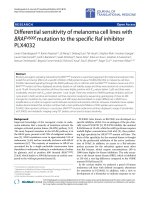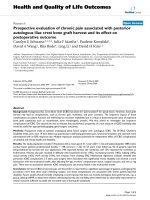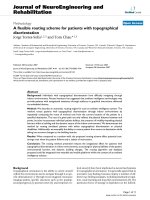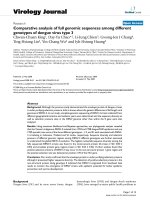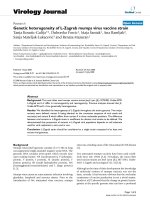Báo cáo hóa học: "Controllable Synthesis of Magnesium Oxysulfate Nanowires with Different Morphologies" potx
Bạn đang xem bản rút gọn của tài liệu. Xem và tải ngay bản đầy đủ của tài liệu tại đây (363.97 KB, 4 trang )
NANO EXPRESS
Controllable Synthesis of Magnesium Oxysulfate Nanowires
with Different Morphologies
X. T. Sun Æ W. T. Shi Æ L. Xiang Æ W. C. Zhu
Received: 1 September 2008 / Accepted: 8 September 2008 / Published online: 24 September 2008
Ó to the authors 2008
Abstract One-dimensional magnesium oxysulfate
5Mg(OH)
2
Á MgSO
4
Á 3H
2
O (abbreviated as 513MOS)
with high aspect ratio has attracted much attention because
of its distinctive properties from those of the conventional
bulk materials. 513MOS nanowires with different mor-
phologies were formed by varying the mixing ways of
MgSO
4
Á 7H
2
O and NH
4
OH solutions at room temperature
followed by hydrothermal treatment of the slurries at
150 ° C for 12 h with or without EDTA. 513MOS nano-
wires with a length of 20–60 lm and a diameter of 60–
300 nm were prepared in the case of double injection
(adding MgSO
4
Á 7H
2
O and NH
4
OH solutions simulta-
neously into water), compared with the 513MOS with a
length of 20–30 lm and a diameter of 0.3–1.7 lminthe
case of the single injection (adding MgSO
4
Á 7H
2
O solu-
tion into NH
4
OH solution). The presence of minor amount
of EDTA in the single injection method led to the forma-
tion of 513MOS nanowires with a length of 100–200 lm, a
diameter of 80–200 nm, and an aspect ratio of up to 1000.
The analysis of the experimental results indicated that the
hydrothermal solutions with a lower supersaturation were
favorable for the preferential growth of 513MOS nano-
wires along b axis.
Keywords Magnesium oxysulfate Á Nanowires Á
Double injection Á EDTA Á Supersaturation
Introduction
One-dimensional (1D) nanostructured magnesium salts
with different morphologies, such as needle [1], rod [2],
wire [3], tube [4], and belt [5], have attracted much
attention because of their unique properties and potential
applications in nanotechnical fields. Up to now much work
has been focused on the control of the morphologies of 1D
513MOS since it can be used as the reinforcing agent, the
flame retardant, or as the precursor for the fabrication of
1D MgO or Mg(OH)
2
[6–8].
It was reported that the 513MOS whisker agglomerates
with a length of up to 200 lm and a diameter of 0.8–
1.2 lm were formed using MgSO
4
and Mg(OH)
2
or MgO
as the reactants [9, 10]. The sector-like 513MOS whiskers
with a length of 20–50 lm and a diameter of 0.2–1.0 lm
were synthesized using MgSO
4
and NaOH as the raw
materials [11–13]. Dispersive 1D 513MOS without
agglomerates or the sector-like were formed by employing
MgSO
4
or the mixture of MgSO
4
and MgCl
2
as the mag-
nesium source and the weak alkali NH
4
OH as the
precipitation agent [14–16]. But little work has been
reported on the control of the sizes (length and diameter) of
the 1D 513MOS and it is still a challenge to synthesize 1D
513MOS with high aspect ratio and perfect uniformity.
Generally the solution with a lower supersaturation was
favorable for the anisotropic or 1D growth of the crystals,
which can be achieved by using dilute reactants or che-
lating agents. For example, it was reported that the
presence of EDTA can control the morphologies and sizes
of the corresponding particles owing to the chelating
effects of EDTA with Ca
2?
[17], Zn
2?
[18], Ce
3?
[19],
Fe
3?
[20], Co
2?
[20], and Bi
3?
[21], which can change the
forms of the aqueous ions, producing a solution with less
free metal ions to control the crystals growth. The growth
X. T. Sun Á W. T. Shi Á L. Xiang (&) Á W. C. Zhu
Department of Chemical Engineering, Tsinghua University,
Beijing 10084, China
e-mail:
X. T. Sun
e-mail:
123
Nanoscale Res Lett (2008) 3:386–389
DOI 10.1007/s11671-008-9171-z
habits of the crystals can also be altered by the capping
effect of EDTA on the surfaces of the crystals.
In the present work the 513 MOS nanowires with high
aspect ratio were formed by precipitation of MgSO
4
and
NH
4
OH solutions at room temperature followed by treat-
ment at hydrothermal conditions. The supersaturations of
the solutions were controlled at relatively low levels, which
were achieved by controlling the mixing ways of the
reactants or addition of EDTA. The preferential orientation
of 513MOS nanowires was identified and the related pro-
cess mechanisms were discussed.
Experimental
Synthesis of 513MOS Nanowires
Commercial reagents (NH
4
OH, MgSO
4
Á 7H
2
O, and
EDTA) with analytical grade provided by Beijing Chemi-
cal Regent Factory were used in the experiments.
Three ways were adapted for the formation of the pre-
cursor slurries at room temperature: (1) Single injection:
35 mL of 1.0–1.5 mol L
-1
MgSO
4
was dropped
(3.0 mL min
-1
) into 20 mL of 5.0–9.0 mol L
-1
NH
4
OH;
(2) Double injection: 35 mL of 1.0–1.5 mol L
-1
MgSO
4
and 20 mL 5.0–9.0 mol L
-1
NH
4
OH were dropped
(3.0 mL min
-1
) simultaneously into 5–10 mL water; (3)
Single injection in the presence of EDTA: 35 mL of 1.0–
1.5 mol L
-1
MgSO
4
mixed with varying amount of EDTA
was dropped (3.0 mL min
-1
) into 20 mL of 5–9 mol L
-1
ammonia.
The slurry formed at room temperature was then trans-
ferred to a Teflon-lined stainless steel autoclave with an
inner volume of 80 cm
3
, heated (5 °C min
-1
) to 150 °C
and kept under isothermal condition for 8.0–12.0 h. The
autoclave was cooled down to room temperature naturally
after hydrothermal treatment and the product was filtrated,
washed, and dried at 105 °C for 12.0 h.
Analysis
The morphology and the microstructure of the samples
were examined with the field emission scanning electron
microscopy (FESEM, JSM 7401F, JEOL, Japan), the high-
resolution transmission electron microscope (HRTEM,
JEM-2010, JEOL, Japan) and the selected area electron
diffraction (SAED). The crystallization and the composi-
tion of the samples were identified by the powder X-ray
diffraction (XRD, D/max2500, Rigaku, Japan) using CuKa
(k = 0.154178 nm) radiation. The solution pH was detec-
ted by Mettler Toledo Delta 320 pH meter. The
concentrations of Mg
2?
and SO
4
2-
were analyzed by
EDTA titration and barium chromate spectrophotometry
(Model 722, Xiaoguang, China), respectively.
Results and Discussion
Figure 1 shows the influence of the preparation ways of the
precursors on the morphologies of the hydrothermal prod-
ucts. 1D product with a length of 20–30 lm and an
ununiform diameter of 0.3 –1.7 lm were prepared via the
single injection route (Fig. 1a). Uniform nanowires with a
length to 20–60 lm and a diameter of 60–300 nm were
fabricated in the case of the double injection route (Fig. 1b),
which may be connected with the decrease of the super-
saturation of 513MOS in the solution due to the dilution of
the reactants and will be discussed in detail later.
The influence of EDTA on the morphologies of the
hydrothermal products was shown in Fig. 2.1Dproductwitha
length of 30–50 lm and a diameter of 0.2–1 lmwereformed
at 1.0 9 10
-3
mol L
-1
EDTA (Fig. 1a). The diameter of the
product decreased to 80–200 nm (Fig. 2 b, c) as the EDTA
concentration increased up to 1.0 9 10
-2
mol L
-1
.The
clusters of the products were composed of the twisted nano-
wires with a length of 100–200 lm and an aspect ratio up to
1,000. The diameter of the product was broadened to
0.15–0.6 lm and the length was about 100 lm in the case of
1.0 9 10
-1
mol L
-1
EDTA (Fig. 2d).
Figure 3 shows the XRD patterns of the hydrothermal
products formed in presence of EDTA. All the diffraction
peaks can be indexed as those of the orthorhombic
5Mg(OH)
2
Á MgSO
4
Á 3H
2
O (PDF No. 070415). The
gradual increase of the diffraction intensities with the
increase of EDTA concentration indicated that the presence
of EDTA was favorable for the crystallization of 1D 513
MOS. It was also noticed that most of the XRD peaks were
attributed to (h0l) planes, indicating that the 513MOS
nanowires may have a preferential growth along b axis
owing to its inherent structure.
The HRTEM image and the SAED pattern of the
513MOS nanowires prepared in the presence of
Fig. 1 The morphologies of the products prepared via single
injection (a) and double injection (b)
Nanoscale Res Lett (2008) 3:386–389 387
123
1.0 9 10
-2
mol L
-1
EDTA were shown in Fig. 4. The
interplanar distances of the lattice fringes parallel (Fig. 4b,
corresponding to the rectangular part of the nanowire in
Fig. 4a) and with a 72° angle (Fig. 4c, corresponding to the
trigonal part of the nanowire in Fig .4a) to the growth
direction of the whiskers were 5.1 and 2.25 A
˚
, quite similar
to the spacing of (202) plane (d (202) = 5.12 A
˚
) and (114)
plane (d (114) = 2.255 A
˚
), respectively, indicating the
preferential orientation of the nanowires along the [010]
direction, which was reconfirmed by the SAED analysis in
Fig. 4d and also identical with the XRD analysis shown in
Fig. 3.
Figure 5 shows the influence of the preparation ways of
the Mg(OH)
2
precursors on the variation of [Mg
2?
] and the
supersaturation of 513MOS with the hydrothermal time.
The supersaturation of 513MOS was presented by
[Mg
2?
]
6
[SO
4
2-
][OH
-
]
10
according to the following for-
mation reaction[13]:
6Mg
2þ
þ SO
2À
4
þ 10OH
À
þ 3H
2
O
¼ 5Mg OHðÞ
2
ÁMgSO
4
Á 3H
2
O ð1Þ
The presence of EDTA led to the decrease of [Mg
2?
]
(Fig. 5a) and the supersaturation of 513MOS (Fig. 5b),
which may be connected with the chelating and/or the
capping effects of EDTA. EDTA can form stable chelating
complexes with Mg
2?
. The slow release of Mg
2?
from the
complexes might be favorable for the 1D growth of
513MOS. The varying binding abilities of EDTA on
different planes may also inhibit the radial growth and
promote the axial growth of the 513MOS nanowires.
The increase of [Mg
2?
] and the supersaturation of
513MOS within initial 8 h of reaction should be attributed
mainly to the dissolution of the Mg(OH)
2
precursor, and
the decrease of [Mg
2?
] and the supersaturation of 513MOS
after 6–10 h of reaction may be connected with the for-
mation of 513MOS. The lower supersaturations of
513MOS achieved in either the double injection route or in
the presence of minor amount of EDTA were favorable for
the formation of 513MOS nanowires with high aspect ratio.
Conclusion
513MOS nanowires with a length of 20–60 lm and a
diameter of 60–300 nm were synthesized via the double
injection-hydrothermal reaction and the uniform 513MOS
nanowires with a length of 100–200 lm and a diameter of
Fig. 2 Influence of EDTA concentrations on the morphologies of the products (a) 1.0 9 10
-3
mol L
-1
;(b, c) (different magnifications)
1.0 9 10
-2
mol L
-1
;(d) 1.0 9 10
-1
mol L
-1
d
b
a
10 20 30 40 50 60 70
0
50000
100000
150000
(804)
(802)
(513)
(604)
(114)
(602)
(601)
(311)
(111)
(402)
(401)
(203)
(202)
(201)
(200)
Intensity (a.u.)
2 (°)
Fig. 3 XRD patterns of the products shown in Fig. 2
Fig. 4 TEM (a), HRTEM images (b, c) and SAED pattern (d)of
513MOS nanowire
388 Nanoscale Res Lett (2008) 3:386–389
123
80–200 nm were formed via single injection EDTA-
assisted hydrothermal reaction route. The lower supersat-
urations of 513MOS achieved in either the double injection
route or in the presence of minor amount of EDTA, were
favorable for the preferential growth of 513MOS along b
axis, leading to the formation of 513MOS nanowires with
high aspect ratios.
Acknowledgment This work is supported by the National Natural
Science Foundation of China (No.50574051).
References
1. Y. Ding, G.T. Zhang, H. Wu, B. Hai, L.B. Wang, Y.T. Qian,
Chem. Mater. 13(2), 435–440 (2001). doi:10.1021/cm000607e
2. J.P. Lv, L.Z. Qiu, B.J. Qu, Nanotechnology 15(12), 1576–1581
(2004). doi:10.1088/0957-4484/15/11/035
3. Y. Li, Z.Y. Fan, J.G. Lu, R.P.H. Chang, Chem. Mater. 16, 2152–
2154 (2004)
4. W.L. Fan, S.X. Sun, L.P. You, G.X. Cao, X.Y. Song, W.M.
Zhang et al., Chem. Mater. 13, 3062–3065 (2003)
5. Z.Z. Zhou, Q.H. Sun, Z.S. Hu, Y.L. Deng, Phys. Chem. B
110(27), 13387–13392 (2006). doi:10.1021/jp0612228
6. H.D. Lu, Y. Hu, J.F. Xiao, Z.Z. Wang, J. Mater. Sci. 41, 363–367
(2006). doi:10.1007/s10853-005-2374-0
7. H.D. Lu, Y. Hu, L. Yang, Z.Z. Wang, Z.Y. Chen, W.C. Fan,
Macromol. Mater. Eng. 289, 984–989 (2004). doi:10.1002/mame.
200400165
8. X.T. Sun, L. Xiang, Mater. Chem. Phys. 109, 381–385 (2008).
doi:10.1016/j.matchemphys.2007.12.005
9. P.H. Ma, Z.Q. Wei, G. Xu, J.Q. Bao, X.M. Wen, J. Mater. Sci.
Lett. 19, 257–258 (2000). doi:10.1023/A:1006779229191
10. Z.Q. Wei, H. Qi, P.H. Ma, J.Q. Bao, Inorg. Chem. Commun. 5,
147–149 (2002). doi:10.1016/S1387-7003(01)00367-7
11. H. Iwanaga, T. Ohyama, K. Reizen, T. Matsunami, J. Ceram.
Soc. Jpn. 102(5), 436–441 (1994)
12. L. Xiang, F. Liu, J. Li, Y. Jin, Mater. Chem. Phys. 87, 424–429
(2004). doi:10.1016/j.matchemphys.2004.06.021
13. J. Li, L. Xiang, Y. Jin, J. Mater. Sci. 41, 1345–1348 (2006). doi:
10.1007/s10853-006-7339-4
14. Y. Ding, G.T. Zhang, S.Y. Zhang, X.M. Huang, W.C. Yu, Y.T.
Qian, Chem. Mater. 12, 2845–2852 (2000). doi:10.1021/
cm000249f
15. X.X. Yan, D.L. Xu, D.F. Xue, Acta Mater. 55, 5747–5757 (2007).
doi:10.1016/j.actamat.2007.06.023
16. D.N. Yang, J. Zhang, R.M. Wang, Z.F. Liu, Nanotechnology 15,
1625–1627 (2004). doi:10.1088/0957-4484/15/11/043
17. K.J. Westin, A.C. Rasmuson, J. Colloid Interface Sci. 282, 370–
379 (2005). doi:10.1016/j.jcis.2004.09.071
18. K.J. Westin, A.C. Rasmuson, J. Colloid Interface Sci. 282, 359–
369 (2005). doi:10.1016/j.jcis.2004.03.029
19. L. Dileo, D. Romano, L. Schaeffer, B. Gersten, C. Foster, M.C.
Gelabert, J. Cryst. Growth 271, 65–73 (2004). doi:10.1016/
j.jcrysgro.2004.07.027
20. F. Luo, C.J. Jia, W. Song, L.P. You, C.H. Yan, Cryst. Growth
Des. 5(1), 137–142 (2005). doi:10.1021/cg049940b
21. D.E. Zhang, X.J. Zhang, X.M. Ni, J.M. Song, H.G. Zheng,
J. Magn. Magn. Mater. 305
, 68–70 (2006). doi:10.1016/j.jmmm.
2005.11.030
24681012
0.0
1.0x10
-46
2.0x10
-46
3.0x10
-46
4.0x10
-46
b
A
B
C
2 4 6 8 10 12
0.2
0.3
0.4
0.5
a
A
B
C
[Mg
2+
]
6
[SO
4
2-
][OH
-
]
10
[Mg
2+
]/mol·L
-1
Hydrothermal time(h)
H
y
drothermal time(h)
Fig. 5 Variations of [Mg
2?
](a)
and super-saturation of 513OS
(b) with hydrothermal time.
Preparation ways of Mg(OH)
2
precursor: A—single injection
without EDTA, B—double
injection without EDTA,
C—single injection with
1.0 9 10
-2
mol L
-1
EDTA
Nanoscale Res Lett (2008) 3:386–389 389
123

